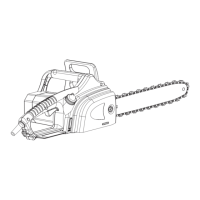6. ADDITIONAL SAFETY RULES FOR CHAIN SAW.
a. Keep all parts of the body away from the saw chain when the chain saw
is operating. Before you start the chain saw, make sure the saw chain is
not contacting anything. A moment of inattention while operating chain saws may
cause entanglement of your clothing or body with the saw chain.
b. Always hold the chain saw with your right hand on the rear handle and
your left hand on the front handle. Holding the chain saw with a reversed hand
conguration increases the risk of personal injury and should never be done.
c. Wear safety glasses and hearing protection. Further protective equipment
for head, hands, legs and feet is recommended. Adequate protective clothing
will reduce personal injury by ying debris or accidental contact with the saw chain.
d. Do not operate a chain saw in a tree. Operation of a chain saw while up in a
tree may result in personal injury.
e. Always keep proper footing and operate the chain saw only when
standing on xed, asecure and level surface. Slippery or unstable surfaces such
as ladders may cause a loss of balance or control of the chain saw.
f. When cutting a limb that is under tension be alert for spring back. When
the tension in the wood bres is released the spring loaded limb may strike the
operator and/or throw the chain saw out of control.
g. Use extreme caution when cutting brush and saplings. The slender material
may catch the saw chain and be whipped toward you or pull you off balance.
h. Carry the chain saw by the front handle with the chain saw switched
off and away from your body. When transporting or storing the chain saw
always t the guide bar cover. Proper handling of the chain saw will reduce the
likelihood of accidental contact with the moving saw chain.
i. Follow instructions for lubricating, chain tensioning and changing
accessories.
Improperly tensioned or lubricated chain may either break or increase the chance for
kickback.
j. Keep handles dry, clean, and free from oil and grease. Greasy, oily handles
are slippery causing loss of control.
k. Cut wood only. Do not use chain saw for purposes not intended. For
example: do not use chain saw for cutting plastic, masonry or non-wood
building materials. Use of the chain saw for operations different than intended could
result in a hazardous situation.
l. The appliance should be supplied via a Residual Current Device (RCD) with
a tripping current of not more than 30mA.
m. The rst time user should have practical instruction in the use of the
chain saw and the protective equipment from an experienced.
5. CAUSES and operator prevention of kickback:
a. Kickback may occur when the nose or tip of the guide bar touches an object, or
when the wood closes in and pinches the saw chain in the cut.
b. Tip contact in some cases may cause a sudden reverse reaction, kicking the guide
bar up and back towards the operator.
c. Pinching the saw chain along the top of the guide bar may push the guide bar
rapidly back towards the operator.
d. Either of these reactions may cause you to lose control of the saw which could
result in serious personal injury. Do not rely exclusively upon the safety devices built

